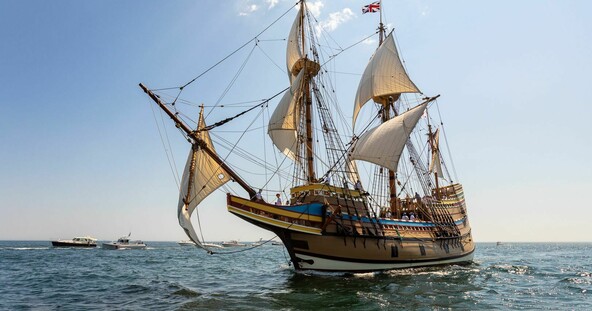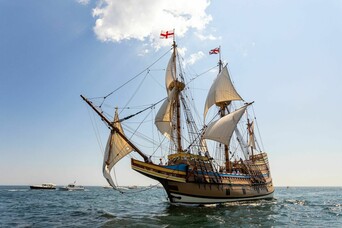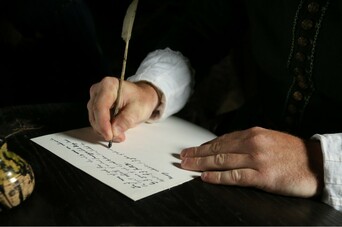
Mayflower and Mayflower Compact
The Journey
Would you have liked to travel on a small ship with more than 100 other people, all of their belongings, and possibly some farm animals – for 66 days? That’s what the Pilgrims did in the year 1620, on a ship called Mayflower.
Mayflower set sail from England in July 1620, but it had to turn back twice because Speedwell, the ship it was traveling with, leaked. After deciding to leave the leaky Speedwell behind, Mayflower finally got underway on September 6, 1620.
In the 1600s, the ocean was full of dangers. Ships could be attacked and taken over by pirates. Many ships in the 1600s were damaged or shipwrecked by storms. Passengers sometimes fell overboard and drowned or got sick and died.
Although Mayflower did not sink, a few of these things actually did happen! Mayflower wasn't taken over by pirates -- the ship sailed on a northern path across the Atlantic to avoid them -- but she was damaged by a bad storm halfway to America. The storm cracked one of the massive wooden beams supporting the frame of the ship. Fortunately, the passengers had brought along a “great iron screw,” which helped raise the beam back into place so the ship could continue. In another storm, a young passenger, John Howland, was swept off the deck of the ship and into the ocean! He was saved because he grabbed onto one of the ship’s ropes (or lines) and was pulled back onto the deck.
Although many people were seasick on the voyage across the Atlantic Ocean, only one person died. He was a sailor who had been very mean to the passengers and taunted them about their seasickness. The colonists believed he died because God was punishing him for being cruel.
One baby was born during the journey. Elizabeth Hopkins gave birth to her first son, appropriately named Oceanus, on Mayflower. Another baby boy, Peregrine White, was born to Susanna White after Mayflower arrived in New England. It must have been very challenging to give birth on a moving ship, with so many people and so much seasickness around.
After more than two months (66 days) at sea, the Pilgrims finally arrived at Cape Cod on November 11, 1620. A few weeks later, they sailed up the coast to Plymouth and started to build their town where a group of Wampanoag People had lived before (a sickness had killed most of them). The Pilgrims lived on the ship for a few more months, rowing ashore to build houses during the day, and returning to the ship at night. Many people began to get sick from the cold and the wet; after all, it was December! About half the people on Mayflower died that first winter from what they described as a “general sickness” of colds, coughs and fevers.
Finally, in March 1621, there were enough houses that everyone could live on land. After a long, hard voyage, and an even harder winter, Mayflower left Plymouth to return to England on April 5, 1621.

The Ship and Its People
Traveling on the ocean 400 years ago was a very different experience than it is today. Mayflower didn’t have private cabins with windows and beds for each person. There were no computers, televisions, air conditioners, fancy meals or swimming pools.
In the 1600s, most ships were merchant ships. They were made for carrying cargo, like barrels of food or cloth, large pieces of wood, and casks of wine, from one place to another to be sold. Before Mayflower sailed to New England, it had been sailing around Europe carrying wine and cloth. This cargo was probably stored in the lower decks of the ship in one large, open storage area. There were no windows on this deck because windows might let in seawater that would ruin the cargo. A little water would leak in anyway, though, so this area was always cold, damp and dark.
The storage decks had very low ceilings. They didn’t need to make the decks very high because barrels and boxes weren’t very tall. The ship had low-ceilinged decks to make it safer and to save space for the decks where the sailors lived. A ship that was too tall might tip over or sink.
The crew (sailors and officers of the ship) lived on the upper decks. In 1620, there were about 20-30 crewmembers on Mayflower. The Master, in charge of sailing the ship, was Christopher Jones. We would call him a “captain” today. He probably had his quarters, or living space, at the stern (the back) of the ship. This was the driest and most comfortable area on the ship.
The common sailors, or regular workers, had their quarters at the front of the ship, or bow, in a room called the forecastle. The forecastle, or fo’c’sle, was not a pleasant place to sleep or eat. It was in a part of the ship constantly hit by waves, so it was always wet and cold. The sailors would have to get used to the swaying and pitching of the ship because it was at its strongest here. Also, most of the men would be going to the bathroom at the head, which was at the very tip of the bow, so the forecastle wasn’t very clean.
There were also officers on Mayflower. They were responsible for sailing and navigating the ship. They probably lived in the space between the Master and the common sailors. Their quarters weren’t as spacious or comfortable as the Master’s, but they weren’t as awful as the space for the common sailors.
Where did the passengers live on Mayflower? The ship carried 102 men, women and children passengers on its only trip to New England. The passengers were the cargo, so they all had to live in the dark, cold cargo decks below the crew’s quarters.

Mayflower Compact
The 1620 agreement (first called the Mayflower Compact in 1793) was a legal instrument that bound the Pilgrims together when they arrived in New England. The core members of the Pilgrims' immigrant group were Separatists, members of a Puritan sect that had split from the Church of England, the only legal church in England at that time. Others in the group, however, had remained part of the Church of England, so not all of the Pilgrims shared the same religion.
When the Pilgrims left England, they obtained permission from the King of England to settle on land farther to the south near the mouth of the Hudson River (in present-day New York). Because they chose to remain where they landed in New England, they needed a new permission (called a patent) to settle there. On November 11, 1620, needing to maintain order and establish a civil society while they waited for this new patent, the adult male passengers signed the Mayflower Compact.
THE TEXT OF THE MAYFLOWER COMPACT:
In the name of God, Amen. We whose names are underwritten, the loyal subjects of our dread Sovereign Lord King James, by the Grace of God of Great Britain, France, and Ireland King, Defender of the Faith, etc.
Having undertaken for the Glory of God and advancement of the Christian Faith and Honour of our King and Country, a Voyage to plant the First Colony in the Northern Parts of Virginia, do by these presents solemnly and mutually in the presence of God and one of another, Covenant and Combine ourselves together in a Civil Body Politic, for our better ordering and preservation and furtherance of the ends aforesaid; and by virtue hereof to enact, constitute and frame such just and equal Laws, Ordinances, Acts, Constitutions and Offices from time to time, as shall be thought most meet and convenient for the general good of the Colony, unto which we promise all due submission and obedience. In witness whereof we have hereunder subscribed our names at Cape Cod, the 11th of November, in the year of the reign of our Sovereign Lord King James, of England, France and Ireland the eighteenth, and of Scotland the fifty-fourth. Anno Domini 1620.
(William Bradford, Of Plymouth Plantation, ed. Samuel Morison, 75-6.)
- John Carver
- William Bradford
- Edward Winslow
- William Brewster
- Isaac Allerton
- Miles Standish
- John Alden
- Samuel Fuller
- Christopher Martin
- William Mullins
- William White
- Richard Warren
- John Howland
- Stephen Hopkins
- Edward Tilly
- John Tilly
- Francis Cooke
- Thomas Rogers
- Thomas Tinker
- John Rigdale
- Edward Fuller
- John Turner
- Francis Eaton
- James Chilton
- John Craxton
- John Billington
- Moses Fletcher
- John Goodman
- Digery Priest
- Thomas Williams
- Gilbert Winslow
- Edmund Margeson
- Peter Brown
- Richard Bitteridge
- George Soule
- Richard Clark
- Richard Gardiner
- John Allerton
- Thomas English
- Edward Doten
- Edward Leister
The original document does not survive. It first appeared in Mourt’s Relation, a pamphlet about the first year of settlement at Plimoth. In 1669 Plymouth’s town historian, Nathaniel Morton, reprinted the agreement in his book, New England’s Memorial. Interestingly, he included a possible list of the men who signed it, even though these men’s names were not included in earlier copies of the Mayflower Compact. According to Morton, the document was signed by 41 of the male passengers – all but one of the freemen, three of the five hired men, and two of the nine servants.